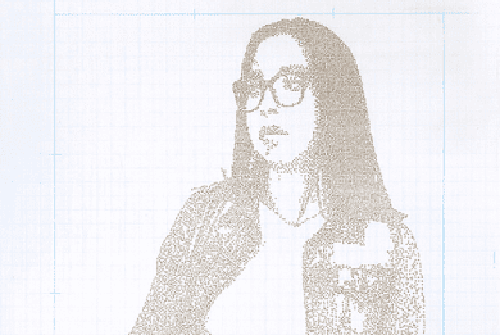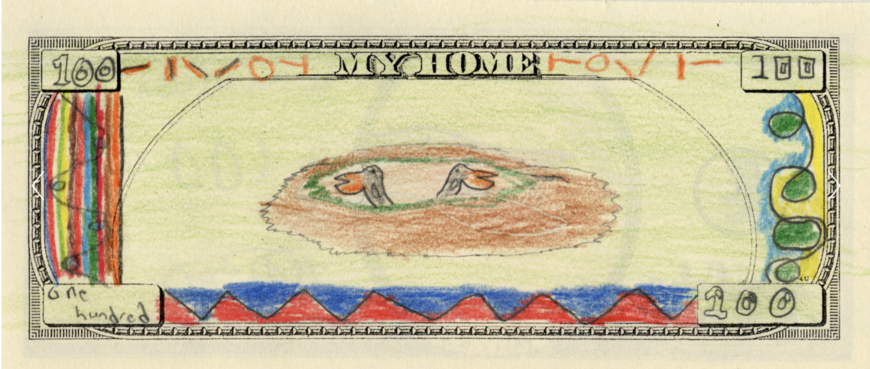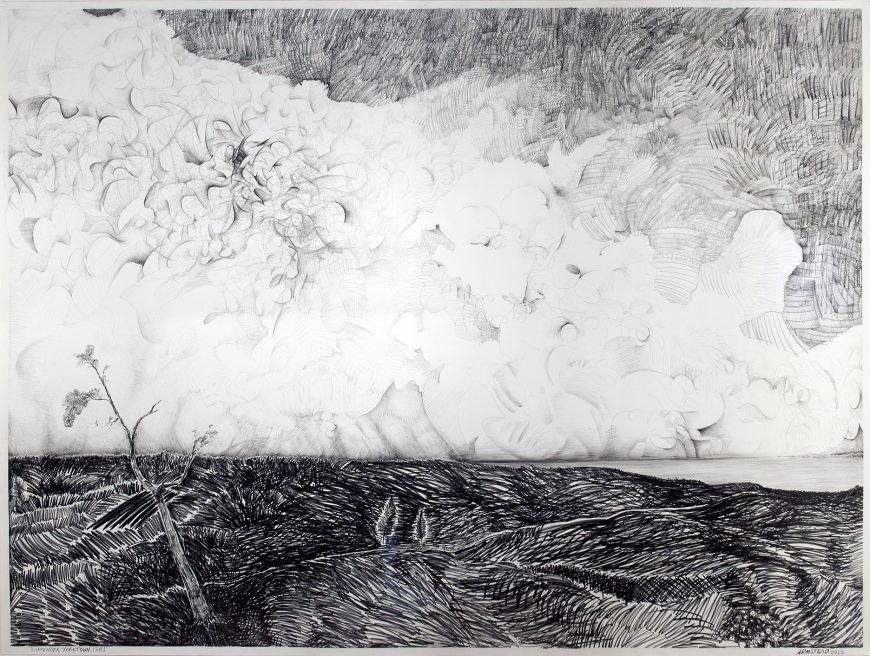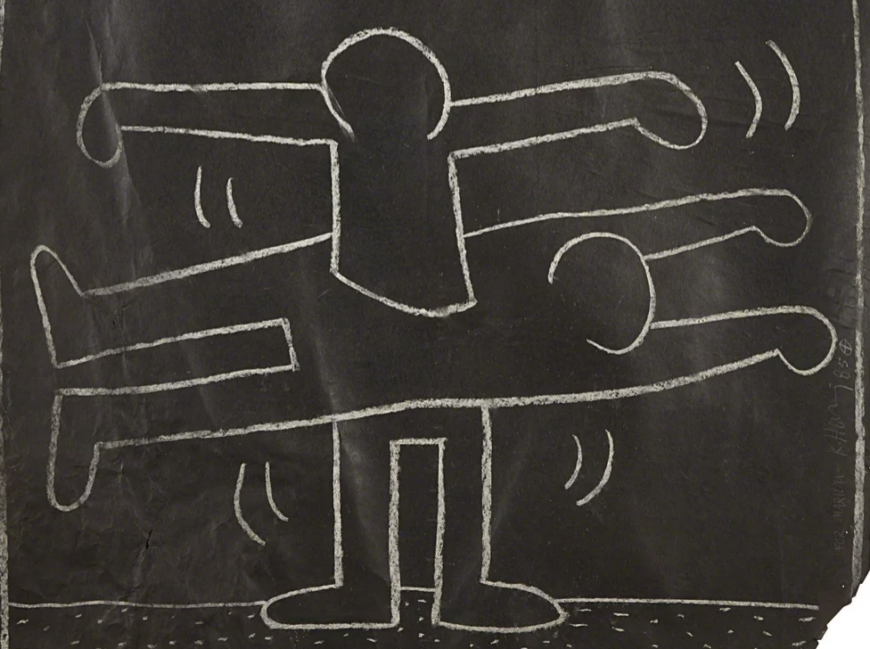Abstracted human, animal, and parasitic forms create both an alluring and grotesque image.
Ilana Savdie, Thirty-Seven Counts, 2023, pen and ink and acrylic on paper and Ilana Savdie, Trismus, 2023, pen and ink and acrylic on paper (Whitney Museum of American Art, New York) © Ilana Savdie. Speakers: Angelica Arbelaez, Rubio Butterfield Family Fellow, Whitney Museum of American Art, and Steven Zucker
0:00:05.3 Angelica Arbelaez: We’re at the Whitney Museum of American Art looking at two works on paper by Ilana Savdie: Trismus and Thirty-Seven Counts.
0:00:13.9 Steven Zucker: Thirty-Seven Counts was made this year, and when I saw the title, I immediately recognized it as one of the first indictments against Donald Trump. I’m trying to reconcile that title with the imagery that I’m seeing. And I know that she’s interested in the way that the body can be an expression of fear, of danger, and of elements that are intruding on the body that don’t belong there.
0:00:37.6 Angelica Arbelaez: Ilana’s work focuses on human bodies, on animal bodies, on bodies of all kinds, and they appear very frequently in her work in the form of fragments. It’s something that she definitely likes to abstract, and the titles are a way for Ilana to ground such abstract work in real world situations or events.
0:01:00.1 Steven Zucker: She does something remarkable, which is to take something that is, at least for me, initially repellent—the organs of the body and the organs being attacked—and then at the same time, through her use of this extraordinary variety of mark making, of textures, of surfaces, she also makes it alluring, beautiful, seductive.
0:01:23.5 Angelica Arbelaez: Ilana does this formally. The tonalities from afar might look really beautiful, or the way that she renders the texture of a parasitic worm or a tendril or tentacle is quite delicate and beautiful, but once your eyes focus in on what they’re actually looking at, you notice that there are more grotesque forms appearing in front of you. I think that bait and switch, or that use of misdirection is something that Ilana’s drawing from tricksters definitely, and specifically I would say, from the marimonda, which is a character that appears in Ilana’s works on paper and paintings.
0:02:00.3 Steven Zucker: And this is a composite creature that incorporates human, monkey, and elephant elements. So like her work, it is bringing together things that don’t belong.
0:02:10.7 Angelica Arbelaez: The features of this character don’t necessarily belong together, but it’s also its behavior. And this character is one that appears in the Carnaval de Barranquilla, which is an annual celebration that takes place in Colombia. Ilana is from Barranquilla and is a frequent attendee to these celebrations and was drawn to the marimonda because of its exaggerated features, because of its exaggerated movements and choreographies that were meant to mock the ruling class. And so that misbehavior is something that she brings technically and conceptually to her work. Ilana tends to start with a gesture or an action of some kind that could be pulling or tugging or stretching, wrapping and some of the forms are doing those things.
0:02:58.6 Steven Zucker: So I’m seeing, or I’m on the edge of seeing, a form that seems as if it could possibly be human and upright, with an arm extending out, a hand falling down, what looks like a knee and perhaps a calf, but then it begins to break down. I’m seeing perhaps a rib cage in the wrong place. I’m seeing that thigh opened up in a way that is quite disturbing. And then beyond that, behind that, forms that look both worm-like or intestinal elements that make me uncomfortable, that should not be exposed.
0:03:32.1 Angelica Arbelaez: Ilana thinks about the relationship between internal and external and does this through representations of the body, but also through representations of something even smaller, like parasites. So parasites can enter the body, and that transgression is something that is really uncomfortable, that breaking down of barriers. And so to have these things be juxtaposed next to each other, I think Ilana likes that tension.
0:03:58.7 Steven Zucker: I’m reminded that we understand scale by clues to context where we’re seeing something. And the artist’s work is so clever in disrupting our sense of scale through a kind of ambiguity of the environment in which these forms are found. There’s that wonderful white space on the left side that is bright. Are we looking into a deeper space? There’s this way that the forms in the foreground float in an uncanny way.
0:04:27.3 Angelica Arbelaez: I think the starkness of the white space next to this amorphous form and then this block of deep darkness is just another way to further unsettle a viewer and dismantle whatever expectations they might have about this work.
0:04:41.7 Steven Zucker: There’s such a variety of tone, of light and dark, and these works on paper do play a significant role in the development of her large scale painting.
0:04:51.6 Angelica Arbelaez: This work on paper is a companion to a painting entitled Helminth. And that title in particular is referring to a parasite that is visible to the naked eye. The forms that you’re seeing in Ilana’s works on paper are under a form of duress, but there are certain moments within these compositions where the forms are either trying to break free or wriggle themselves out. And there is this tension, but there’s also a kind of resistance.
0:05:18.3 Steven Zucker: The sense of tension that we see enacted would normally make me want to side with the body that’s being invaded. There is a kind of complication that overrides that traditional sense of good and evil.
0:05:30.0 Angelica Arbelaez: The gestures or the actions that Ilana is drawing attention to make it apparent that there is a sort of struggle. I think the work is drawing from what’s happening in the world politically, culturally. However, I think the work itself is much more focused on what those events do to the body. And that is in the form of trying to break free from something or trying to wrap yourself around something. I think it’s very much about trying to capture a sense of unease, of turmoil, of survival.











